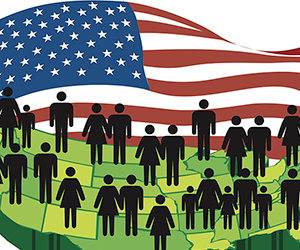You count! Get counted in the 2020 Census
The impact of an undercount in the 2020 U.S. Census would be felt in Northwest Kansas for a decade.
It could cause a significant loss of federal funding, impact the area’s ability to inform government decisions about agriculture, water and other critical issues and make the area less attractive to businesses considering expansion.
However, the solution is easy: Go online and make sure you are counted by April 1, which is Census Day. Then make sure your friends, neighbors and co-workers do the same.
This year, online participation in the census will be available for the first time. The census can also be completed over the phone, by mail or by talking to a census employee.
Paige Wilson, media specialist with U.S. Census Bureau in Kansas, said almost all area residents should have received a sealed letter in the mail from the U.S. Census Bureau between March 12 and March 20 that contained a geocode specific to their physical address. They can use the code to respond online or by phone, although the code is not required to respond.
The online portal opened March 12, and people can respond online immediately.
“We encourage everyone to respond just as quickly as they got that letter in the mail, and then they’re finished and done with it, and hopefully won’t get a visit from us;’ Wilson said.
She said the census will utilize a total of five mailings. Everyone will get the initial letter and a reminder about a week later, but only people who don’t respond during the first five or six weeks of the census will get all five mailings.
For people who have a post office box, the letter will be dropped off at their home by a census worker.
“We encourage everyone to self-respond, whether they do it online, by phone or through a form,” Wilson said. “When someone’s filling it out for themselves, it tends to be a lot more accurate. Online is our preferred portal because it’s faster and more efficient, and it saves the government a little money in the cost of mailingsf
Wilson said although people can’t request a paper form, if that is their preferred method of responding they can wait for the fourth reminder mailing, which will contain a paper form. She said areas that have been identified as having low internet connectivity will receive a paper form sooner.
It will only take a few minutes to respond to the 10 census questions and ensure that you are counted. Your participation will have impact in the area for the 10 years until the next census.
According to the 2010 census and subsequent estimates as recent as 2017, in the 26 Northwest Kansas counties served by the Dane G. Hansen Foundation:
The county with the most young residents is Ellis, with a median age of 32. However, the median ages of residents in Saline, Sherman and Thomas counties is also in the 30s.
The county with the most older residents is Jewell County, where the median age is 51.9. Decatur, Graham, Rawlins, Republic and Smith counties also have a median age in the 50s.
Some counties bucked an overall trend toward population decline. The county showing the highest percentage of growth is Wallace, where the number of residents is estimated to have grown 7 percent from 1,485 to 1,591. Other counties showing growth are Ellis, which grew by 1.5 percent; Logan, which grew by 1.2 percent; Rawlins, which added one resident; and Russell, which grew by 0.2 percent.
Census questions ask the names, ages, genders and races of everyone living in the household. The information is used for statistical purposes only, and no individual is identified. The Census Bureau does not ask for money, a full Social Security number, bank or credit card account numbers or information about political affiliation.
The Census Bureau collects data on everyone - regardless of U.S. citizenship - at the residence where they usually live and sleep. By law, information collected is CONFIDENTIAL and cannot be shared with law enforcement agencies, immigration authorities or be used to determine eligibility for government benefits.
For some people, participating in the census will require no effort on their part. People living in nursing homes, military bases, students living in college campus housing and inmates in jail or prison will be counted by those institutions. Census enumerators will follow a protocol to count homeless people as well.
People who travel seasonally between residences or parents who share joint custody of children, may find it difficult to determine a primary residence. In that case, the individual or child should be counted wherever he or she is on April 1.
College students living away from their parental home while attending college are counted at the on-campus or off-campus residence where they live most of the time. Students who live off-campus will need to complete the census with their roommates.
People who complete the census on their own won’t need to interact with census enumerators. During the 2010 census, 72 percent of households nationwide responded to the census without being visited by a census worker.
The Census Bureau also sends a small sample of the population a more detailed questionnaire called the American Community Survey, and anyone who receives it will need to complete it as well as the census questions, Wilson said. The ACS is conducted annually and gathers additional data about housing, income, education level, employment status, health insurance coverage and other subjects. ACS information, which is used for statistical purposes without identifying any individuals, informs policy and planning decisions on the local, state and federal level.
The U.S. Census Bureau must submit state population totals to the president of the United States by Dec. 31. More detailed results will be provided to states within a year.



